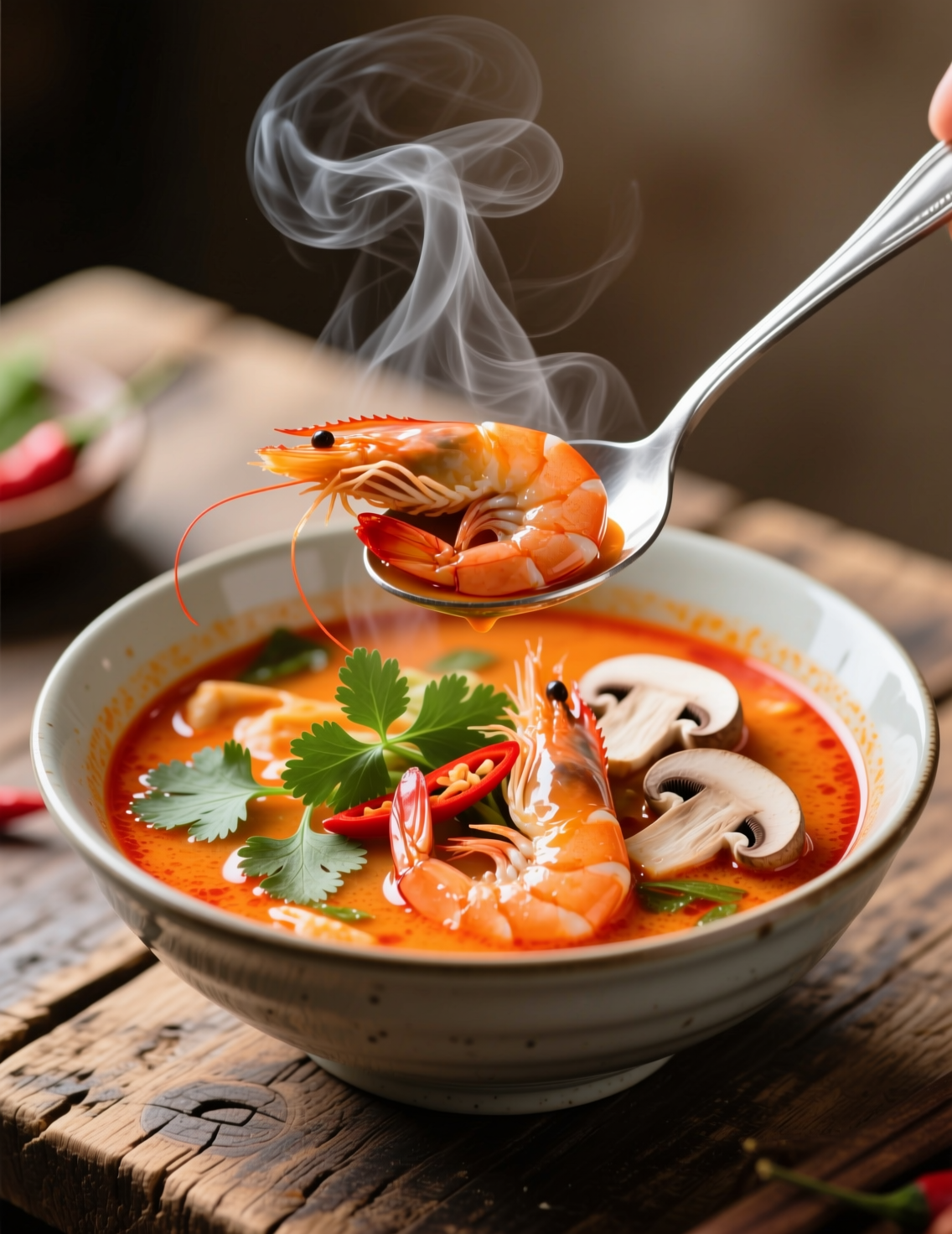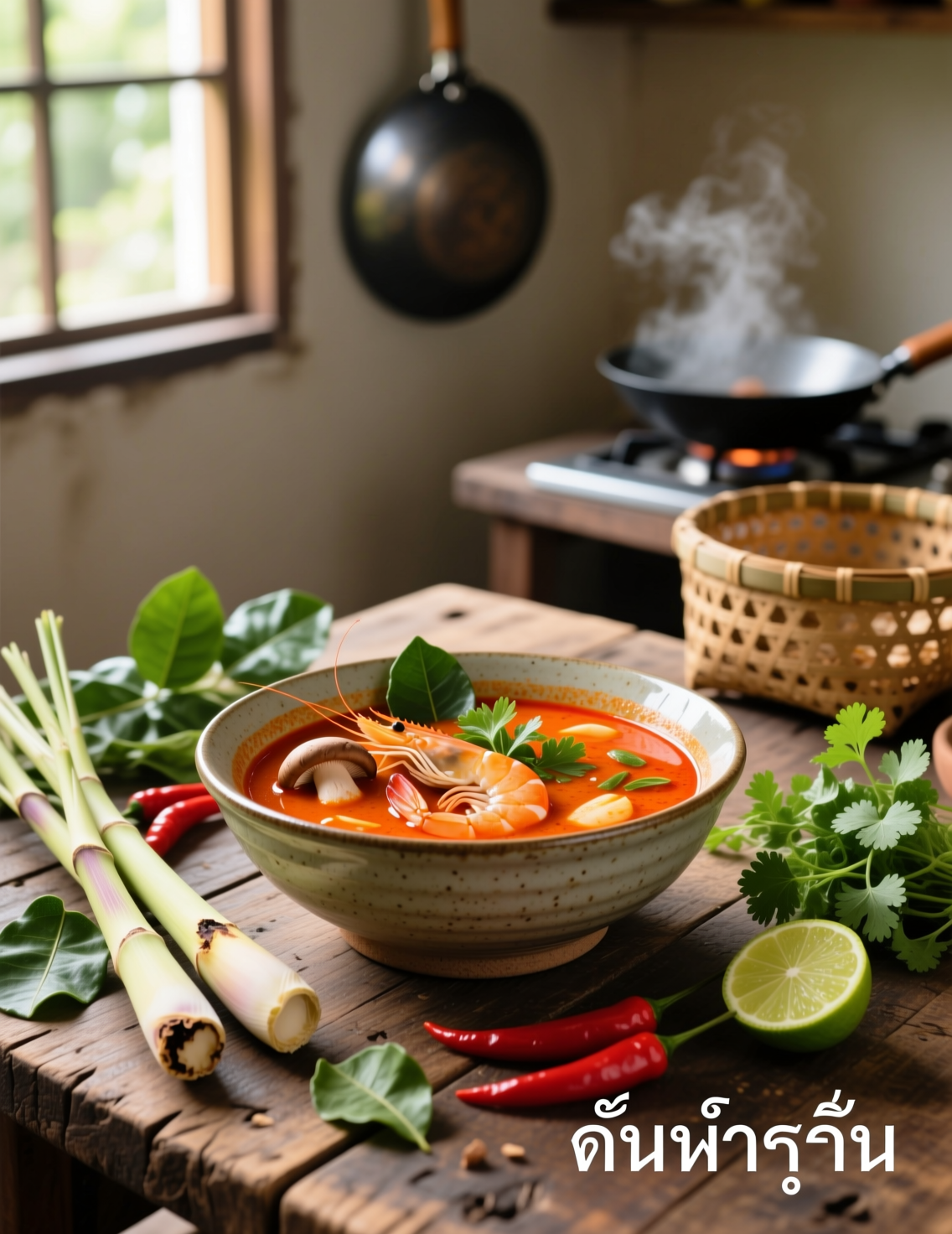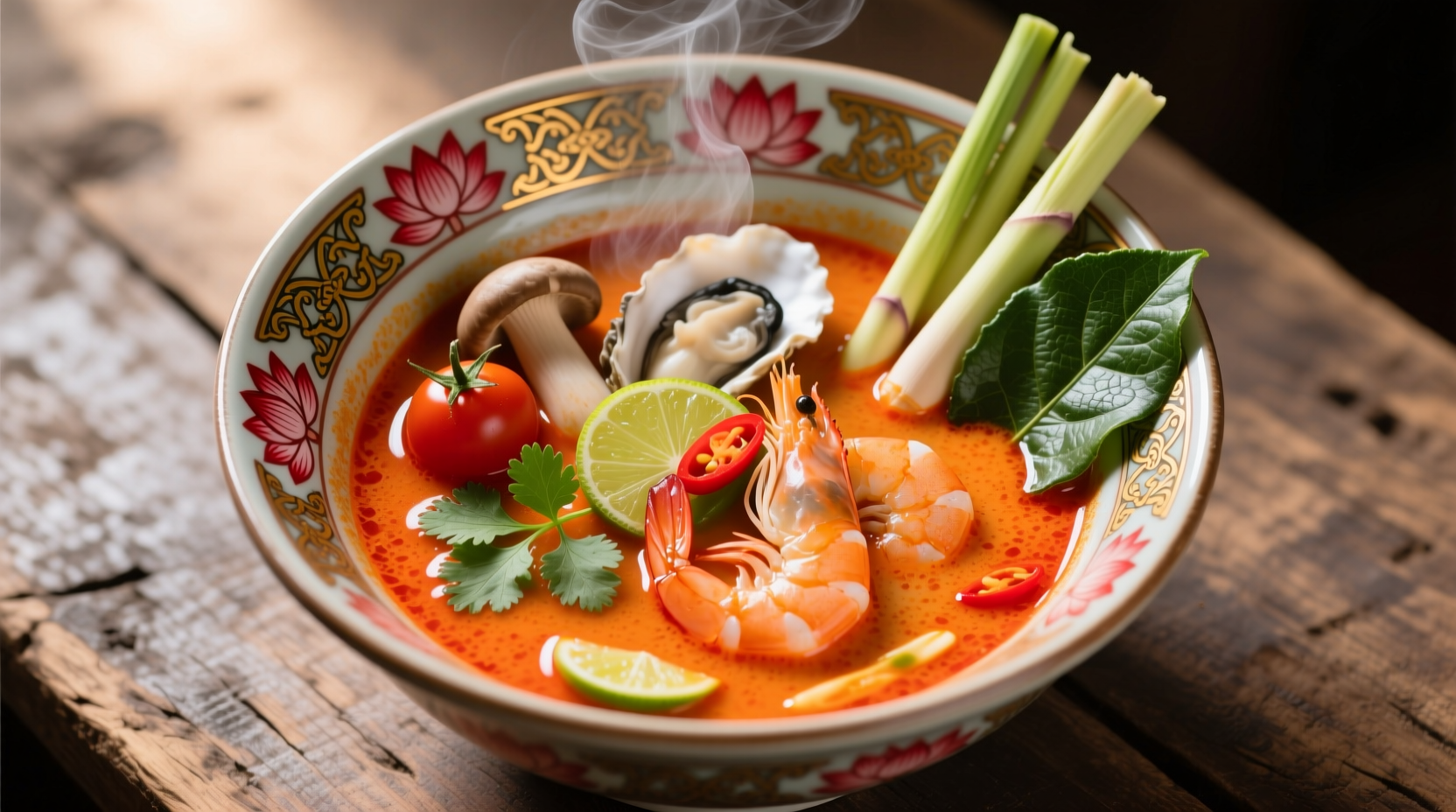Tom Yum soup is not just another dish from Thai cuisine. It’s a cultural symbol, a balance of heat, sourness, and fragrance that captures the Thai philosophy of flavor harmony. When people ask me what defines Thai cooking, I don’t talk about Pad Thai. I point to Tom Yum, because it’s where technique, ingredients, and precision collide. In this article, I’ll walk you through a professional-level recipe for six servings, while digging deep into its nuances, techniques, and why this humble soup continues to fascinate chefs worldwide.
Why Tom Yum Stands Apart
Tom Yum is the soup that makes people remember Thailand. The combination of lemongrass, kaffir lime leaves, galangal, and chili creates a fragrance you can smell from a distance. It’s not just flavor—it’s almost medicinal. Research has shown that galangal and lemongrass have anti-inflammatory properties, and many nutritionists describe Tom Yum as one of the healthiest soups in the world. But beyond health, it’s that unmistakable layering of spicy, sour, salty, and a touch of sweet that hooks you.
Some chefs misunderstand Tom Yum, thinking it’s just chili and lime juice tossed into broth. That’s a rookie error. The real depth comes from the precise timing of when each aromatic enters the pot, and how the broth interacts with proteins like shrimp or chicken. Done right, the soup is bright and layered. Done sloppy, it becomes muddied and harsh.
The Essential Ingredients
If you’re preparing this soup for six people, precision matters. The measurements I’m giving are professional kitchen tested, scaled for consistency.
- Shrimp (with shells and heads, if possible): 18 large (about 1 kg). The shells are non-negotiable if you want depth of flavor.
- Chicken stock or water: 10 cups (2.5 liters). Stock adds depth, but clear water works if aromatics are strong.
- Lemongrass stalks: 3, bruised and cut into 2-inch pieces. Don’t slice too thin, or they’ll float around like splinters.
- Galangal: 8 thin slices, fresh preferred. Ginger is not a substitute, no matter what some Western cookbooks suggest.
- Kaffir lime leaves: 10, torn slightly to release oils.
- Bird’s eye chilies: 12, lightly crushed. Adjust heat but never skip them; they’re the soul of the dish.
- Fish sauce: 6 tablespoons. It’s the salt of this dish.
- Lime juice: Juice of 5 limes, fresh squeezed. Bottled lime juice is a culinary crime here.
- Nam prik pao (Thai chili paste): 3 tablespoons. This brings sweetness and smokiness.
- Straw mushrooms or oyster mushrooms: 3 cups, halved if large.
- Cilantro: A handful, roughly chopped, for garnish.
- Optional additions: A splash of evaporated milk or coconut milk if making Tom Yum Nam Khon (creamy style).
Notice I didn’t include sugar. Real Tom Yum doesn’t need it unless your chili paste is overly sharp. Professionals balance sweetness with technique, not sugar as a crutch.

Building the Broth Base
This is where experience separates chefs from home cooks. Start by heating the stock until it simmers—not a rolling boil. Drop in the lemongrass, galangal, kaffir lime leaves, and chilies. Let it infuse gently for about 10 minutes. If you rush this, you’ll get surface-level aroma but no body.
Professional Thai kitchens often roast shrimp shells before adding them to the broth. That caramelization deepens the umami, creating a soup that feels rounder in the mouth. If you’ve got the time, roast the shells under a hot grill for 5 minutes, then simmer them with your broth. This tiny step transforms the dish from good to unforgettable.
Adding Protein and Mushrooms
Once your broth smells alive—fragrant, citrusy, almost floral—add the mushrooms. They soak up flavor beautifully but release moisture, so give them a few minutes to simmer. Next, drop in the shrimp. Here’s the golden rule: never overcook shrimp. They should turn pink and curl slightly, about 2–3 minutes. Pull them the second they’re done, or you’ll end up with rubber bands floating in broth.
For chefs working in volume, one trick is to poach shrimp separately and only return them at plating. That way, every diner gets perfectly cooked shrimp instead of ones that sat too long.
The Balance of Flavors
Now comes the delicate part. Season the soup with fish sauce, then add the chili paste. Taste it. It should be salty, smoky, and just beginning to kick. Only after that do you stir in lime juice. Always lime last. Heat destroys its brightness, so it should go in after the soup is off the flame.
Thai chefs will often dip a spoon and taste multiple times, adjusting drop by drop. This isn’t obsessive—it’s essential. Tom Yum lives and dies by its balance. If it’s too salty, add more lime. If it’s too sour, a dash more fish sauce. Never fix imbalance with sugar; it dulls the fire of the dish.
Professional Tips for Scaling
Cooking Tom Yum for six isn’t just doubling a recipe meant for three. Flavors don’t scale linearly. For example, six limes for six servings will overwhelm the soup. That’s why I recommend starting with five and tasting. In professional kitchens, chefs taste constantly because ingredients vary—chilies from one batch may be twice as hot as another.
If you’re prepping ahead for service, hold off on adding lime juice and shrimp until the last moment. The broth can sit infused, even overnight. But once you drop lime, the clock ticks fast. Sourness fades and turns flat if reheated too many times.
Nutritional Insights
Studies conducted by Kasetsart University in Thailand have shown that Tom Yum soup has compounds that may boost immune function. The galangal and kaffir lime leaves contain essential oils that help fight bacteria. A typical serving, depending on protein choice, lands around 250 calories, low in fat but rich in antioxidants. This is partly why Thai people regard Tom Yum not just as food but as something restorative, almost like chicken soup in Western culture.
Chefs should be aware of the health appeal when serving to international audiences. Diners are increasingly looking for dishes that not only taste good but also make them feel good. Tom Yum ticks both boxes effortlessly.
Common Misconceptions
One common misconception is that coconut milk is always part of Tom Yum. That’s incorrect. There are two main types—Tom Yum Nam Sai (clear broth) and Tom Yum Nam Khon (creamy broth, with evaporated or coconut milk). Many Western restaurants default to the creamy style, but in Thailand, the clear broth is more traditional and considered purer in flavor.
Another mistake is substituting ginger for galangal. They’re cousins, but the flavor is vastly different. Ginger is sharp and peppery; galangal is citrusy, pine-like, almost camphoraceous. Swap them and you’ve made another soup entirely.
Emerging Trends in Professional Kitchens
Modern Thai chefs are experimenting with proteins beyond shrimp—think soft-shell crab, scallops, or even plant-based versions with tofu and seaweed. The structure of Tom Yum’s broth allows it to carry different proteins without losing identity. In Michelin-starred Thai restaurants, you’ll sometimes see lobster Tom Yum, served in delicate portions.
There’s also a trend of deconstructed Tom Yum, where chefs separate the elements—lime gel, chili oil, galangal-infused broth—served almost like a tasting menu course. While not traditional, it shows how this soup has transcended its humble origins to become a playground for innovation.

Step-by-Step Professional Recipe for 6 Servings
- Heat 10 cups chicken stock in a pot.
- Add 3 bruised lemongrass stalks, 8 slices galangal, 10 kaffir lime leaves, and 12 crushed chilies. Simmer 10 minutes.
- Roast shrimp shells under a broiler for 5 minutes. Add to broth, simmer 5 more minutes, strain if desired.
- Add 3 cups mushrooms, simmer 3 minutes.
- Add 18 shrimp, cook until pink (2–3 minutes). Remove shrimp and hold aside.
- Stir in 6 tablespoons fish sauce and 3 tablespoons chili paste. Taste and adjust.
- Turn off heat. Add juice of 5 limes. Stir gently.
- Return shrimp, garnish with cilantro. Serve hot.
This yields six generous servings. Pair it with jasmine rice to round out the meal.
Final Thoughts
Tom Yum soup is deceptively simple yet endlessly complex. It demands respect for timing, ingredients, and balance. For professionals, it’s not just another Thai dish but a masterclass in flavor orchestration. When you serve it right, diners don’t just taste sour and spicy—they feel a story unfolding in their mouth.
As chefs, our job isn’t only to replicate recipes but to carry their soul intact. Tom Yum’s soul lies in its brightness, its warmth, and its harmony. If you learn to master this dish for six, you’ll find it scales to sixty with the same precision, as long as you keep tasting, adjusting, and respecting the broth.
FAQs
What is the difference between Tom Yum Nam Sai and Tom Yum Nam Khon?
Nam Sai is clear broth, while Nam Khon is creamy with evaporated or coconut milk.
Can I substitute ginger for galangal in Tom Yum soup?
No, galangal has a citrusy, pine-like flavor that ginger can’t replicate.
How many servings does this recipe make?
The recipe makes six generous servings.
Why should shrimp shells be roasted before adding to broth?
Roasting deepens umami and adds a richer flavor to the soup.
Can Tom Yum soup be reheated?
Yes, but add lime juice and shrimp only before serving for best flavor.
Is Tom Yum soup healthy?
Yes, it’s low in calories and rich in antioxidants, making it both light and nutritious.
How do I balance flavors in Tom Yum?
Adjust fish sauce for saltiness and lime juice for sourness—taste often.
What protein alternatives can be used instead of shrimp?
You can use chicken, scallops, crab, tofu, or even lobster.
Can I use bottled lime juice for Tom Yum soup?
No, always use fresh lime juice for authentic brightness.
What makes Tom Yum soup unique compared to other soups?
Its bold balance of spicy, sour, salty, and aromatic flavors makes it unlike any other.

Mariana is a passionate home cook who creates delicious, easy-to-follow recipes for busy people. From energizing breakfasts to satisfying dinners and indulgent desserts, her dishes are designed to fuel both your body and hustle.
When she’s not in the kitchen, she’s exploring new flavors and dreaming up her next recipe to share with the Foodie Hustle community.

